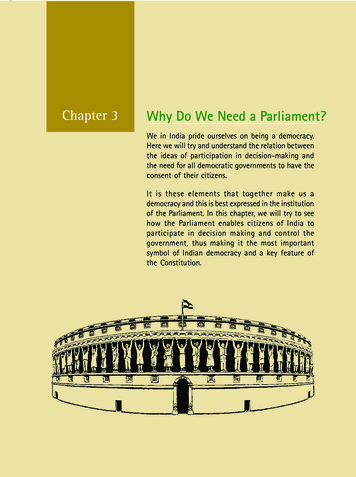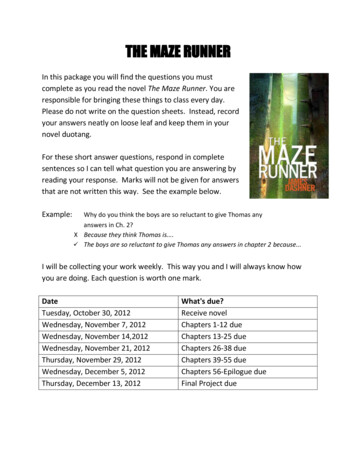
Transcription
Chapter 3Why Do We Need a Parliament?We in India pride ourselves on being a democracy.Here we will try and understand the relation betweenthe ideas of participation in decision-making andthe need for all democratic governments to have theconsent of their citizens.It is these elements that together make us ademocracy and this is best expressed in the institutionof the Parliament. In this chapter, we will try to seehow the Parliament enables citizens of India toparticipate in decision making and control thegovernment, thus making it the most importantsymbol of Indian democracy and a key feature ofthe Constitution.Social and Political Life30
India, as we know, became independent on 15 August 1947.Preceding this was a long and difficult struggle in whichmany sections of society participated. People from variousbackgrounds joined the struggle and they were inspired bythe ideas of freedom, equality and participation in decision–making. Under colonial rule, the people had lived in fearof the British government and did not agree with many ofthe decisions that they took. But they faced grave danger ifthey tried to criticise these decisions. The freedommovement changed this situation. The nationalists beganto openly criticise the British government and makedemands. As far back as 1885, the Indian National Congressdemanded that there be elected members in the legislaturewith a right to discuss the budget and ask questions. TheGovernment of India Act 1909, allowed for some electedrepresentation. While these early legislatures under theBritish government were in response to the growingdemands of the nationalists, they did not allow for all adultsto vote nor could people participate in decision making.As you read in Chapter 1, the experience of colonial rule aswell as the participation of different people in the strugglefor freedom left little doubt in the minds of the nationaliststhat all persons in independent India would be able toparticipate in making decisions. With the coming ofindependence, we were going to be citizens of a freecountry. This did not mean that the government could dowhat it felt like, it meant that the government had to besensitive to people’s needs and demands. The dreams andaspirations of the freedom struggle were made concrete inthe Constitution of independent India that laid down theprinciple of universal adult franchise, i.e. that all adultcitizens of the country have the right to vote.31What do you think the artistis trying to convey throughthe image of Parliament onthe previous page?Why Do We Need aParliament?Why should People Decide?The above photo shows a voter readinginstructions on how to use an Electronic VotingMachine (EVM). EVMs were used throughoutthe country for the first time in the 2004general elections. The use of EVMs in 2004saved around 1,50,000 trees which wouldhave been cut to produce about 8,000 tons ofpaper for printing the ballot papers.Chapter 3: Why Do We Need a Parliament?
Give one reason why you thinkthere should be universal adultfranchise.Do you think there would beany difference if the classmonitor was selected by theteacher or elected by thestudents? Discuss.People and their RepresentativesThe take-off point for a democracy is the idea of consent, i.e.the desire, approval and participation of people. It is thedecision of people that creates a democratic government anddecides about its functioning. The basic idea in this kind ofdemocracy is that the individual or the citizen is the mostimportant person and that in principle the government as wellas other public institutions need to have the trust of thesecitizens.How does the individual give approval to the government? Oneway of doing so, as you read, is through elections. People wouldelect their representatives to the Parliament, then, one groupfrom among these elected representatives forms the government.The Parliament, which is made up of all representatives together,controls and guides the government. In this sense people, throughtheir chosen representatives, form the government and alsocontrol it.This photo shows election staff using anelephant to carry polling material and EVMs topolling stations located in difficult terrain.Social and Political Life32
The above idea of representation has been an important themein your Class VI and VII Social and Political Life textbooks. Youare familiar with how representatives are chosen at differentlevels of government. Let us recall these ideas by doing thefollowing exercises.1. Use the terms ‘constituency’ and ‘represent’ to explain who an MLA is and how theperson gets elected?2. Discuss with your teacher the difference between a State Legislative Assembly(Vidhan Sabha) and the Parliament (Lok Sabha).3. From the list below, identify the work of a State government and that of a Centralgovernment.(a) The decision of the Indian government to maintain peaceful relationswith China.(b) The decision of the Madhya Pradesh government to discontinue Boardexams in Class VIII for all schools under this Board.(c) Introduction of a new train connection between Ajmer and Mysore.(d) Introduction of a new 1,000 rupee note.4. Fill in the blanks with the following words.universal adult franchise; MLAs; representatives; directlyQDemocratic governments in our times are usually referred to as representativedemocracies. In representative democracies, people do not participate . but, instead, choose their . .through an election process. These . .meet and make decisions for the entire population. These days, a governmentcannot call itself democratic unless it allows what is known as .This means that all adult citizens in the country are allowed to vote.5. You have read that most elected members whether in the Panchayat, or the VidhanSabha or the Parliament are elected for a fixed period of five years. Why dowe have a system where the representatives are elected for a fixed period and notfor life?6. You have read that people participate in other ways and not just through electionsto express approval or disapproval of the actions of government. Can you describethree such ways through a small skit?33Chapter 3: Why Do We Need a Parliament?
1231. The Parliament of India (Sansad) is the supreme law-making institution. It has two Houses, the Rajya Sabha and the Lok Sabha.2. Rajya Sabha (Council of States), with a total strength of 245 members, is chaired by the Vice-President of India.3. Lok Sabha (House of the People), with a total membership of 545, is presided over by the Speaker.The Role of the ParliamentCreated after 1947, the Indian Parliament is an expression of thefaith that the people of India have in principles of democracy.These are participation by people in the decision-making processand government by consent. The Parliament in our system hasimmense powers because it is the representative of the people.Elections to the Parliament are held in a similar manner as theyare for the state legislature. The Lok Sabha is usually electedonce every five years. The country is divided into numerousconstituencies as shown in the map on page 41. Each of theseconstituencies elects one person to the Parliament. The candidateswho contest elections usually belong to different political parties.Social and Political Life34
With the help of the table below, let us understandthis further.Results of the 16th Lok Sabha Elections, (May 2014)Political PartyNational PartiesBharatiya Janata Party (BJP)Communist Party of India (CPI)Communist Party of India (Marxist) (CPM)Indian National Congress (INC)Nationalist Congress Party (NCP)State Parties (Regional Parties)Aam Aadmi Party (AAP)All India Anna Dravida Munnetra KazhagamAll India Trinamool CongressAll India United Democratic FrontBiju Janata Dal (BJD)Indian National Lok Dal (INLD)Indian Union Muslim League (IUML)Jammu and Kashmir Peoples Democratic PartyJanata Dal (Secular)Janata Dal (United)Jharkhand Mukti Morcha (JMM)Lok Jan Shakti PartyRashtriya Janata Dal (RJD)Samajwadi Party (SP)Shiromani Akali DalShiv SenaTelangana Rashtra Samithi (TRS)Telugu Desam (TDP)Other Regional PartiesRegistered Unrecognised PartiesIndependentsGrand TotalUse the table alongside toanswer the questions below:No. of MPsWho will form thegovernment? Why?28219446Who will be present fordiscussions in the Lok Sabha?Is this process similar to whatyou have read about inClass VII?4373432022322264541811167163The photograph on page 28shows results from the 3rd LokSabha elections held in 1962.Use the photograph to answerthe following questions:a. Which state has the highestnumber of MPs in the LokSabha? Why do you think thisis so?b. Which state has the leastnumber of MPs in the LokSabha?c. Which political party haswon the most seats in allstates?d. Which party do you thinkwill form the government? Givereasons why.543Source: http://.eci.nic.in35Chapter 3: Why Do We Need a Parliament?
Results of the 15th Lok Sabha Elections,(May 2009)Political PartyNo. of MPsNational PartiesBahujan Samaj Party (BSP)21Bharatiya Janata Party (BJP)116Communist Party of India (CPI)4Communist Party of India (Marxist) 16(CPM)Indian National Congress (INC)206Nationalist Congress Party (NCP)9Rashtriya Janata Dal (RJD)4State Parties (Regional Parties)All India Anna DMK (AIADMK)9All India Forward Bloc2All India Trinamool Congress19Biju Janata Dal (BJD)14Dravida Munnetra Kazhagam (DMK) 18Jammu & Kashmir National Conference 3Janata Dal (Secular)3Janata Dal (United)20Jharkhand Mukti Morcha2Muslim League Kerala State Committee 2Revolutionary Socialist Party2Samajwadi Party (SP)23Shiromani Akali Dal4Shiv Sena11Telangana Rashtra Samithi (TRS)2Telugu Desam (TDP)6Other Regional Parties6Registered Unrecognised Parties12Independents9Grand Total543A. To Select the National GovernmentParliament of India consists of the President, the RajyaSabha and the Lok Sabha. After the Lok Sabha elections,a list is prepared showing how many MPs belong toeach political party. For a political party to form thegovernment, they must have a majority of elected MPs.Since there are 543 elected (plus 2 Anglo-Indiannominated) members in Lok Sabha, to have a majoritya party should have at least half the number i.e. 272members or more. The Opposition in Parliament isformed by all the political parties that oppose themajority party/coalition formed. The largest amongstthese parties is called the Opposition party.One of the most important functions of the LokSabha is to select the executive. The executive, asyou read in Chapter 1, is a group of persons whowork together to implement the laws made by theParliament. This executive is often what we havein mind when we use the term government.The Prime Minister of India is the leader of theruling party in the Lok Sabha. From the MPs whobelong to her party, the Prime Minister selectsministers to work with her to implementdecisions. These ministers then take charge ofdifferent areas of government functioning likehealth, education, finance etc.Often times in the recent past it has been difficultfor a single political party to get the majority thatis required to form the government. They thenjoin together with different political parties whoare interested in similar concerns to form what isknown as a coalition government.Source: www.eci.nic.inThe above table gives you the results of the 15thLok Sabha elections held in 2009. In theseelections, the INC got a large number of seats butstill not enough to emerge as the majority party inthe Lok Sabha. It, thus, had to form a coalition,the United Progressive Alliance (UPA), with otherpolitical parties who were its allies.Social and Political LifeOnce elected, these candidates become Membersof Parliament or MPs. These MPs together makeup the Parliament. Once elections to theParliament have taken place, the Parliament needsto perform the following functions:36
These two buildings of the Central Secretariat, the South Block and North Block were built during the 1930s. The photo on the left is of the SouthBlock which houses the Prime Minister’s Office (PMO), the Ministry of Defence and the Ministry of External Affairs. The North Block is the photo onthe right and this has the Ministry of Finance and the Ministry of Home Affairs. The other ministries of the Union Government are located in variousbuildings in New Delhi.The Rajya Sabha functions primarily as the representativeof the states of India in the Parliament. The Rajya Sabhacan also initiate legislation and a bill is required to passthrough the Rajya Sabha in order to become a law. It,therefore, has an important role of reviewing and altering(if alterations are needed) the laws initiated by the LokSabha. The members of the Rajya Sabha are elected by theelected members of the Legislative Assemblies of variousstates. There are 233 elected members plus 12 membersnominated by the President.B. To Control, Guide and Inform the GovernmentThe Parliament, while in session, begins with a question hour.The question hour is an important mechanism through whichMPs can elicit information about the working of thegovernment. This is a very important way through whichthe Parliament controls the executive. By asking questionsthe government is alerted to its shortcomings, and also comesto know the opinion of the people through theirrepresentatives in the Parliament, i.e. the MPs. Askingquestions of the government is a crucial task for every MP.The Opposition parties play a critical role in the healthyfunctioning of a democracy. They highlight drawbacks invarious policies and programmes of the government andmobilise popular support for their own policies.37Chapter 3: Why Do We Need a Parliament?
The following is an example of a question asked in the Parliament.LOK SABHAUNSTARRED QUESTION NO 2007 ANSWERED ON 30.11.2007JUNK FOOD IN SCHOOLS2007. SHRI SALARAPATTY KUPPUSAMY KHARVENTHANWill the Minister of WOMEN AND CHILD DEVELOPMENT be pleased to state:(a) whether the National Commission for Protection of Child Rights (NCPCR) has asked allState Governments to ban junk foods in schools and also for setting up of nutritionstandards;(b) if so, the details thereof;(c) whether the Union Government has ensured the compliance of the above standards bythe States; and(d) if so, the details thereof.ANSWERTHE MINISTER OF STATE OF THE MINISTRY OF WOMEN AND CHILD DEVELOPMENT(a) and (b) No, Sir. A letter was issued to the States by National Commission for Protection ofChild Rights (NCPCR) to consider providing guidelines to schools to create a school nutritionpolicy.(c) and (d) Does not arise.Source: http://loksabha.nic.inIn the above question, whatinformation is being soughtfrom the Minister of Womenand Child Development?If you were a Member ofParliament (MP), list twoquestions that you would liketo ask.Social and Political LifeThe government gets valuable feedback and is kept onits toes by the questions asked by the MPs. In addition,in all matters dealing with finances, the Parliament’sapproval is crucial for the government. This is one of theseveral ways in which the Parliament controls, guidesand informs the government. The MPs as representativesof the people have a central role in controlling, guidingand informing Parliament and this is a key aspect of thefunctioning of Indian democracy.38
C. Law-MakingLaw-making is a significant function of Parliament. We shallread about this in the next chapter.Who are the People in Parliament?Parliament now has more and more people from differentbackgrounds. For example, there are more rural members asalso members from many regional parties. Groups and peoplesthat were till now unrepresented are beginning to get electedto Parliament.There has also been an increase in political participation fromthe Dalits and backward classes. Let us look at the followingtable that shows the percentage of the population who votedin Lok Sabha elections in different years.Lok SabhaElection YearsVoter Turnout th200958.1916th201466.40Looking at this table wouldyou say that people’sparticipation during the past50 years has:decreased/increased/beenstable after initial increase?Source: http://eci.nic.inIt has been observed that representative democracy cannotproduce a perfect reflection of society. There is a realisationthat when interests and experiences separate us it isimportant to ensure that communities that have beenhistorically marginalised are given adequate representation.With this in mind, some seats are reserved in Parliament forSCs and STs. This has been done so that the MPs elected fromthese constituencies will be familiar with and can represent Dalitand Adivasi interests in Parliament.39Chapter 3: Why Do We Need a Parliament?
Similarly, it has more recently been suggested that there shouldbe reservation of seats for women. This issue is still beingdebated. Sixty years ago, only four per cent of MPs were womenand today it is just above nine per cent. This is a small sharewhen you consider the fact that half the population are women.The above photo shows a few women Membersof Parliament.Why do you think there are sofew women in Parliament?Discuss.It is issues of this kind that force the country to ask certaindifficult and often unresolved questions about whether ourdemocratic system is representative enough. The fact thatwe can ask these questions and are working towardsanswers is a reflection of the strength and the faith thatpeople in India have in a democratic form of government.GLOSSARYApproval: To give one’s consent to and be favourable towards something. In thecontext of this chapter, it refers both to the formal consent (through electedrepresentatives) that Parliament has as well as the fact that it needs to continueto enjoy the people’s trust.Coalition: A temporary alliance of groups or parties. In this chapter, it refers to thealliance formed by political parties after elections when no party has been able toget adequate seats to form a clear majority.Unresolved: Situations in which there are no easy solutions to problems.Social and Political Life40
Exercises1. Why do you think our national movement supported the idea that all adults have a right to vote?2. In this 2004 map of Parliamentary constituenciesalongside, roughly identify the constituencies inyour State. What is the name of the MP from yourconstituency? How many MPs does your statehave? Why are certain constituenciescoloured green while others arecoloured blue?Source: www.eci.gov.in3. You have read in Chapter 1 that the ‘Parliamentary form of government’ that exists in India hasthree tiers. This includes the Parliament (central government) and the various State Legislatures(state governments). Fill in the following table with information on the various representativesfrom your area:State GovernmentCentral GovernmentWhich political party/parties is/arecurrently in power?Who (name) is the currentrepresentative from your area?Which political parties currentlyform the Opposition?When were elections last held?When will the next electionsbe held?How many women representativesare there (from your state)?41Chapter 3: Why Do We Need a Parliament?
constituencies as shown in the map on page 41. Each of these constituencies elects one person to the P arliament. The candida tes who contest elections usuall y belong to diff erent political par ties. 1 1. The Parliament of India (Sansad) is the supreme law-making institution. It has two Houses, the Rajya Sabha and the Lok Sabha. 2.











